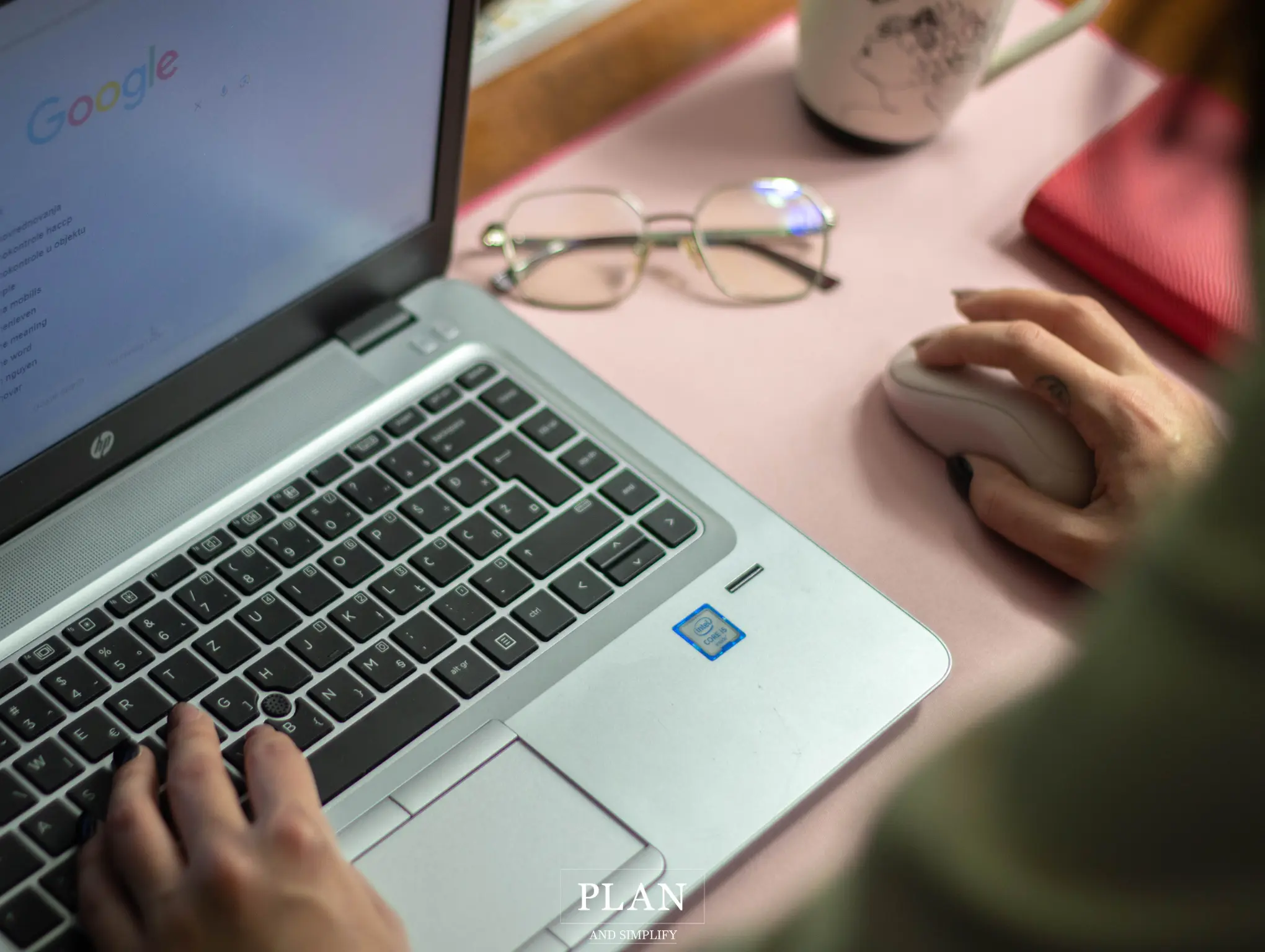Staying organized at work doesn’t always come naturally. Some days, my desk looks like I’ve just survived a paper based tornado, and my brain is juggling 27 tabs (literally and mentally). But over time, I’ve found practical ways to bring order into the chaos – without fancy tools, subscriptions, or forcing myself to do it.
So, if you’re asking yourself, “how do I stay organized at work?”, I’ve got you covered with simple & free tools, good habits, and tips that work in real life – even on those days when coffee is your only friend.

Tip 1: Master Your Calendar
My organization system starts with Google Calendar. I don’t just use it for meetings – I schedule everything.
I block time for focused work, set reminders for deadlines, and even schedule breaks. Color coding helps me instantly recognize the type of activity: blue for meetings, green for deep work, yellow for administrative tasks. This visual system lets me see at a glance if my day has a healthy balance or if I’m overloaded with meetings.
Pro tip: Schedule “buffer time” between meetings. Those 15 minute gaps give you time to process notes, prepare for the next meeting, or just breathe.
Tip 2: Harness the Power of Simple Task Management
Google Tasks integrates with both Calendar and Gmail, making it my go to for tracking action items. What makes it work for me is its simplicity combined with its connectivity to other Google tools. I use it as my to-do list for work.
When an email requires action, I convert it to a task with one click. The email stays linked to the task, so I have all context when I’m ready to tackle it. I can also assign due dates that show up on my calendar, creating a unified view of my commitments.
Tip 3: Create Your Digital Sticky Notes
For quick notes, ideas, and lists, Google Keep is unbeatable. It’s like having sticky notes that never fall off your monitor. It’s simple but incredibly effective for organizing work tasks. I use it for:
- Meeting notes that need to be referenced later
- Project ideas that come up while working on something else
- Lists of resources for various projects
- Quick checklists for recurring processes
What makes Keep especially useful is the ability to add labels and color coding. My system includes labels like “Project Ideas,” “Meeting Notes,” and “Resources,” with a color scheme that matches my calendar categories.
Tip 4: Implement the Daily Top 3 Method
Each morning, I write down the three most important tasks for the day on a sticky note. This focused list cuts through the noise of a lengthy digital task list and keeps my priorities front and center.
The sticky note serves as a visual reminder on my desk that’s harder to ignore than a minimized app.
Tip 5: Practice Weekly Planning
I created a simple one page weekly planning template that I print each Friday for the coming week. It includes:
- Weekly priorities (maximum 3)
- Daily top 3 tasks
- Reminder section for notes and follow-ups
This view helps me ensure my daily activities align with weekly goals, preventing the common trap of being busy without being productive.
Tip 6: Follow the “Touch It Once” Principle to Stay Organized at Work
One rule that transformed my workday is the “touch it once” principle. When a new task, email, or request comes in, I make an immediate decision about it:
- If it takes less than 2 minutes, I do it immediately
- If it requires more time, I schedule it in my calendar
- If I need to reference it later, I file it in the appropriate system
This approach prevents the backlog of “I’ll deal with this later” items that often become overwhelming.
Email Management System
My email inbox stays manageable because I process it using the touch-it-once principle, combined with a folder system:
| Folder Name | Purpose | When to Review |
|---|---|---|
| ✔ Action Required | Emails needing response/action | During scheduled “email time” |
| ⏳ Waiting For | Emails where I’m waiting on someone else | Monday morning review |
| 📃 Reference | Important info I’ll need later | As needed |
| 📓 Archives | Everything else worth keeping | Searchable when needed |
This system ensures my inbox contains only unprocessed items, reducing the mental load of seeing the same emails repeatedly.
Tip 7: Organize Tomorrow Today
How to stay organized at work without feeling overwhelmed in the morning? The last 10 minutes of my workday are sacred: I use them to organize what I’ll work on tomorrow. This includes:
- Reviewing what I accomplished today
- Setting my top 3 priorities for tomorrow
- Checking my calendar for preparation needed
- Clearing my desk for a fresh start
This habit ensures I start each day with clarity rather than spending the first 30 minutes figuring out what to do.
Tip 8: Conduct a Weekly Review
Every Friday afternoon, I conduct a 30 minute review of the week. I ask myself:
- What went well this week?
- What didn’t go as planned?
- What did I learn?
- What needs to change for next week?
This builds good work habits by giving your brain space to focus. It’s way easier to be organized at work when you’re aware of what you may need to reschedule for the next week.
Tip 9: Create Purpose-Built Spreadsheets
Spreadsheets can be powerful organizational tools when designed thoughtfully. Here are two I’ve created that save me hours each month:
The Project Tracker
My project tracker spreadsheet includes:
- Project name and brief description
- Current status (Not Started, In Progress, Waiting For Input, Complete)
- Next action required
- Due date
- Dependencies
- Notes
I color-code rows based on priority and status, creating a visual dashboard that helps me focus on what needs attention.
The Decision Log
For complex projects, I maintain a decision log spreadsheet that tracks:
- Decision made
- Date
- Context/reasoning
- People involved
- Impact on timeline/budget
- Alternatives considered
This document has saved me countless times when questions arise about why certain paths were chosen.
Tip 10: Implement a “Waiting For” System
Every Monday morning, I review my “Waiting For” list – tasks where I’m dependent on someone else. This simple habit prevents things from falling through the cracks and allows me to follow up appropriately.
I track these items in a dedicated Google Tasks list and my project spreadsheet with a “Waiting For” status column. This dual-tracking ensures nothing gets missed when I’m dependent on others to move forward.
FAQ: Staying Organized at Work
People often ask me about my organization system. Here are answers to the most common questions.
Begin with one system (like the daily top 3) and practice it for two weeks before adding another. Trying to overhaul everything at once often leads to abandoning the entire effort.
The more unpredictable your work, the more you need flexible organization systems. Use time blocking for types of work rather than specific tasks. For example, block “responsive time” for handling unexpected issues while protecting other blocks for planned work.
I use the same tools but separate accounts for work and personal. My work and personal Gmail accounts both feed into my phone, but with different notification settings. For tasks, I maintain separate lists but review them together during weekly planning to ensure I’m balancing priorities across my whole life.
The visual noise of an open office can derail even the best organizational system. I use noise canceling headphones and a “focus mode” notification on my desk (a small sign that signals I’m not available for casual interruptions). I also schedule my focused work during quieter office hours when possible.
Final Thoughts on Being Organized at Work
The best system is the one you’ll use consistently, so experiment with these ideas and adapt them to your work style. Combining tools like Google Calendar, Keep, and Tasks creates a seamless workflow, so if you’re not already using these, you can start there.
What organization challenge are you tackling this week? Whatever it is, having the right tools and habits can make all the difference.
